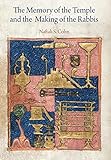The Memory of the Temple and the Making of the Rabbis / Naftali S. Cohn.
Material type: TextSeries: Divinations: Rereading Late Ancient ReligionPublisher: Philadelphia : University of Pennsylvania Press, [2013]Copyright date: ©2013Description: 1 online resource (256 p.) : 5 illusContent type:
TextSeries: Divinations: Rereading Late Ancient ReligionPublisher: Philadelphia : University of Pennsylvania Press, [2013]Copyright date: ©2013Description: 1 online resource (256 p.) : 5 illusContent type: - 9780812244571
- 9780812207460
- 296.4/91 23
- BM509.T46 C64 2013eb
- online - DeGruyter
- Issued also in print.
| Item type | Current library | Call number | URL | Status | Notes | Barcode | |
|---|---|---|---|---|---|---|---|
 eBook
eBook
|
Biblioteca "Angelicum" Pont. Univ. S.Tommaso d'Aquino Nuvola online | online - DeGruyter (Browse shelf(Opens below)) | Online access | Not for loan (Accesso limitato) | Accesso per gli utenti autorizzati / Access for authorized users | (dgr)9780812207460 |
Browsing Biblioteca "Angelicum" Pont. Univ. S.Tommaso d'Aquino shelves, Shelving location: Nuvola online Close shelf browser (Hides shelf browser)

|

|

|

|

|

|

|
||
| online - DeGruyter Peasant Scenes and Landscapes : The Rise of Pictorial Genres in the Antwerp Art Market / / | online - DeGruyter Violence and Belief in Late Antiquity : Militant Devotion in Christianity and Islam / | online - DeGruyter Forging Rights in a New Democracy : Ukrainian Students Between Freedom and Justice / | online - DeGruyter The Memory of the Temple and the Making of the Rabbis / | online - DeGruyter Poetics of the Incarnation : Middle English Writing and the Leap of Love / | online - DeGruyter Varieties of Sovereignty and Citizenship / | online - DeGruyter Regulatory Breakdown : The Crisis of Confidence in U.S. Regulation / |
Frontmatter -- Contents -- Notes on Usage -- Introduction. The Narration of Temple Ritual as Rabbinic Memory in the Late Second or Early Third Century -- Chapter 1. Rabbis as Jurists of Judaean Ritual Law and Competing Claims for Authority -- Chapter 2. The Temple, the Great Court, and the Rabbinic Invention of the past -- Chapter 3. Narrative form and Rabbinic Authority -- Chapter 4. Constructing Sacred Space -- Chapter 5. The Mishnah in the Context of a Wider Judaean, Christian, and Roman Temple Discourse -- Conclusion: The Memory of the Temple and the Making of the Rabbis -- Appendix A: The Mishnah's Temple Ritual Narratives and Court-Centered Ritual Narratives -- Appendix B: Mishnaic Narratives in Which a Rabbi or Rabbis Issue an Opinion with Respect to a Case -- Notes -- Bibliography -- Index -- Acknowledgments
restricted access online access with authorization star
http://purl.org/coar/access_right/c_16ec
When the rabbis composed the Mishnah in the late second or early third century C.E., the Jerusalem Temple had been destroyed for more then a century. Why, then, do the Temple and its ritual feature so prominently in the Mishnah? Against the view that the rabbis were reacting directly to the destruction and asserting that nothing had changed, Naftali S. Cohn argues that the memory of the Temple served a political function for the rabbis in their own time. They described the Temple and its ritual in a unique way that helped to establish their authority within the context of Roman dominance.At the time the Mishnah was created, the rabbis were not the only ones talking extensively about the Temple: other Judaeans (including followers of Jesus), Christians, and even Roman emperors produced texts and other cultural artifacts centered on the Jerusalem Temple. Looking back at the procedures of Temple ritual, the rabbis created in the Mishnah a past and a Temple in their own image, which lent legitimacy to their claim to be the only authentic purveyors of Jewish tradition and the traditional Jewish way of life. Seizing on the Temple, they sought to establish and consolidate their own position of importance within the complex social and religious landscape of Jewish society in Roman Palestine.
Issued also in print.
Mode of access: Internet via World Wide Web.
In English.
Description based on online resource; title from PDF title page (publisher's Web site, viewed 24. Apr 2022)


